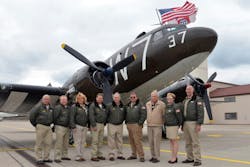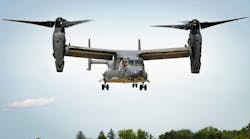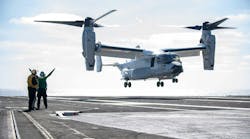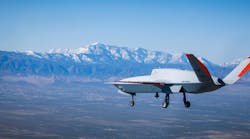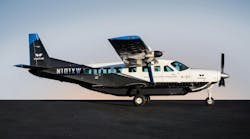May 28--RAMSTEIN AIR BASE, Germany -- Parked on the flight line of this bustling military air field, the twin-engine, propeller-driven plane looked like a borrowed relic from an aviation museum.
Though it's old, the C-47 that dropped Allied paratroops behind enemy lines before dawn on June 6, 1944, isn't done flying, yet.
The plane, known as the Whiskey 7, landed at Ramstein on Monday after a smooth 3,600-mile trans-Atlantic crossing that marked its longest journey since shortly after World War II.
Its final destination is Normandy, France, where the aircraft and its crew will spend 10 days participating in commemorations marking the 70th anniversary of D-Day and paying tribute to the war's fallen and surviving soldiers.
Ramstein was an important stop along the way because of the plane's historical ties to the 37th Airlift Squadron.
During the war, Whiskey 7 was assigned to the 37th Troop Carrier Squadron, from which the 37th Airlift Squadron, now based at Ramstein, draws its lineage. The aircraft is believed to be the only remaining airworthy C-47 from the original carrier squadron, a distinctive status that sparked the bold idea for the plane's return to Normandy.
About two years ago, the squadron contacted the National Warplane Museum in Geneseo, New York, and asked whether the museum might consider sending its flagship plane to Ramstein to help commemorate the squadron's own 70th anniversary, said Naomi Wadsworth, 55, one of the Whiskey 7's pilots.
"We just couldn't pull it together that fast," Wadsworth said. It was February, not a conducive time to cross the Atlantic due to the potential for wing icing and stormy weather. "And we didn't have the funding," she said.
"Then the whole Normandy thing came up," Wadsworth said. Around the same time, Gary Mitchell, a museum member and World War II buff who passed away in September, received an invitation from France to bring Whiskey 7 to the D-Day anniversary.
Though fundraising continues, the museum has almost reached its goal of $250,000 needed for the trip, money that mostly covers fueling the slow, low-flying plane that so far on its journey to Normandy has guzzled more than 2,000 gallons. In Narsarsuag, Greenland, the plane's third stop, the going rate for 100 low-lead fuel was $20 to $25 per gallon.
Countless Saturdays leading up to the May 15 departure were spent prepping the plane's engines, tires, landing gear, electrical systems and other components. After departing from Geneseo, a five-member volunteer crew -- three pilots, a crew chief and a maintenance chief -- made the short hop to Presque Isle, Maine, the northernmost piece of land on the eastern U.S. coast. The plane proceeded to follow the original Blue Spruce Route, an air route over the North Atlantic used to ferry aircraft between the United States and Great Britain during World War II.
"We were blessed with the weather on our trip," said chief pilot Chris Polhemus, 58, on Wednesday while briefing reporters at Ramstein. "We're just tickled to death to be here."
Air Force Capt. Brian Shea, a C-130 pilot with the 37th Airlift Squadron, was also thrilled to see the plane parked a few steps outside the squadron's doors.
"It was great to see the history of our squadron roll up," he said. "I'm just jealous that I can't fly it."
The C-47 will be available for public viewing by ID cardholders on Ramp 2-5 by the 37th Airlift Squadron from 9 a.m. to 1 p.m. Thursday, and 1-4 p.m. Friday.
It's hard to imagine flying the plane like it was during the war, Shea said. "The courage that they had to be able to take an aircraft like this and fly the way they did, not only with the flak and all the air defenses out there, but the number of aircraft that were in the air that day, the number of paratroopers, it's just something that we don't do anymore," he said. "I can't imagine putting it together."
Back then, after departing from RAF Cottesmore, England, the lead aircraft in the second wave across the English Channel, Whiskey 7 dropped a planeload of paratroops from the 82nd Airborne Division on Drop Zone '0' near St.-Mere Eglise, France, at shortly past 2 a.m. on June 6, 1944.
"It was one of a handful of airplanes that actually put its troops directly on the drop zone ... it was one of the very successful drops," Polhemus said.
After the war, the aircraft flew for the Canadian armed forces, then hauled commercial freight and later fell into the hands of a private aviator. The museum acquired the aircraft as a gift with its current paint and markings, from the former owner's family, said Whiskey 7 flight engineer Craig Wadsworth. "It's never been out of flying status since World War II," he said.
It has been given some upgrades, however. A modern radio and touch-screen navigation system made the crossing less challenging than it would have been 70 years ago, said Craig Wadsworth, Naomi's younger brother. But conditions inside the plane on its most recent journey are still far from luxurious.
"It's not bumpy but it is cold," Craig Wadsworth said. "There is a heating system on board but it's really just effective enough to make sure the pilots' feet sweat."
The noninsulated cabin at one point dropped to 28 degrees Fahrenheit. Wadsworth and crew chief Mike Lindsay sat in the canvas jump seats bundled in sleeping bags and thermal underwear. The toilet was a five-gallon drum with a hole and seat on top.
Packed into the plane, just in case, are life rafts, parachutes and wet suits.
"Did I think we would make it? Absolutely," Wadsworth said. "Am I ecstatic, incredibly pleased and relieved at how well the airplane is operating? Absolutely."
At Goose Bay in Labrador, Canada, the crew had to change a defunct generator, one of two powering the aircraft's electrical systems.
"If anyone has a spare generator for a C-47, see me before they leave," Craig Wadsworth joked.
Other than that, the trip has been mostly smooth, with trailing winds boosting the plane's average speed of 130 knots (about 149 miles per hour) to 180 knots (about 207 miles per hour) -- about one-quarter to one-third the average cruising speed of a commercial jet liner.
While in Normandy, the crew will meet up with 90-year-old Leslie Palmer Cruise Jr., a paratrooper who jumped from Whiskey 7 on D-Day. Though the plane will execute several re-enactment parachute drops in Normandy, Cruise this time around has no plans for a flak-filled, nighttime free fall.
"We offered to let him jump out, but he said the last time he parachuted into France, he didn't get a very good reception," Craig Wadsworth said.
Thinking back on the young men who did jump 70 years ago is what inspired Polhemus, a longtime pilot for US Airways, to take the plane back to Normandy.
"I frequently sit in the back of this airplane and I look at the ribs, the stringers, the rivets, the very same airframe" that those kids were looking at 70 years ago, he said. "They jumped from 700 feet into the night skies into German-occupied France, small-arms fire, not knowing what they were going to find.
"Bringing this airplane to Normandy this year, it puts the United States on the world stage. This airplane is nothing more than a symbol of where we were, what we did, why we did it ... it's who we are, our values."
Copyright 2014 - Stars and Stripes
